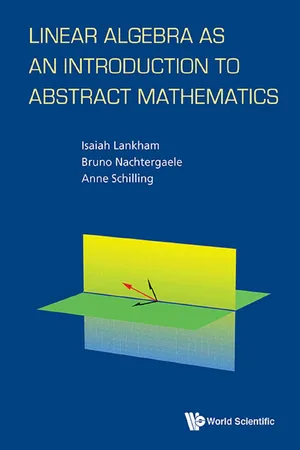
Linear Algebra as an Introduction to Abstract Mathematics
- 208 pages
- English
- ePUB (mobile friendly)
- Available on iOS & Android
Linear Algebra as an Introduction to Abstract Mathematics
About this book
This is an introductory textbook designed for undergraduate mathematics majors with an emphasis on abstraction and in particular, the concept of proofs in the setting of linear algebra. Typically such a student would have taken calculus, though the only prerequisite is suitable mathematical grounding. The purpose of this book is to bridge the gap between the more conceptual and computational oriented undergraduate classes to the more abstract oriented classes. The book begins with systems of linear equations and complex numbers, then relates these to the abstract notion of linear maps on finite-dimensional vector spaces, and covers diagonalization, eigenspaces, determinants, and the Spectral Theorem. Each chapter concludes with both proof-writing and computational exercises.
Request Inspection Copy
This is an introductory textbook designed for undergraduate mathematics majors with an emphasis on abstraction and in particular, the concept of proofs in the setting of linear algebra. Typically such a student would have taken calculus, though the only prerequisite is suitable mathematical grounding. The purpose of this book is to bridge the gap between the more conceptual and computational oriented undergraduate classes to the more abstract oriented classes. The book begins with systems of linear equations and complex numbers, then relates these to the abstract notion of linear maps on finite-dimensional vector spaces, and covers diagonalization, eigenspaces, determinants, and the Spectral Theorem. Each chapter concludes with both proof-writing and computational exercises.
Request Inspection Copy
Readership: Undergraduates in mathematics.
Frequently asked questions
- Essential is ideal for learners and professionals who enjoy exploring a wide range of subjects. Access the Essential Library with 800,000+ trusted titles and best-sellers across business, personal growth, and the humanities. Includes unlimited reading time and Standard Read Aloud voice.
- Complete: Perfect for advanced learners and researchers needing full, unrestricted access. Unlock 1.4M+ books across hundreds of subjects, including academic and specialized titles. The Complete Plan also includes advanced features like Premium Read Aloud and Research Assistant.
Please note we cannot support devices running on iOS 13 and Android 7 or earlier. Learn more about using the app.
Information
Chapter 1
What is Linear Algebra?
1.1Introduction
1.2What is Linear Algebra?
- Characterization of solutions: Are there solutions to a given system of linear equations? How many solutions are there?
- Finding solutions: How does the solution set look? What are the solutions?







Table of contents
- Cover Page
- Title
- Copyright
- Contents
- Preface
- 1. What is Linear Algebra?
- 2. Introduction to Complex Numbers
- 3. The Fundamental Theorem of Algebra and Factoring Polynomials
- 4. Vector Spaces
- 5. Span and Bases
- 6. Linear Maps
- 7. Eigenvalues and Eigenvectors
- 8. Permutations and the Determinant of a Square Matrix
- 9. Inner Product Spaces
- 10. Change of Bases
- 11. The Spectral Theorem for Normal Linear Maps
- Appendices
- Index